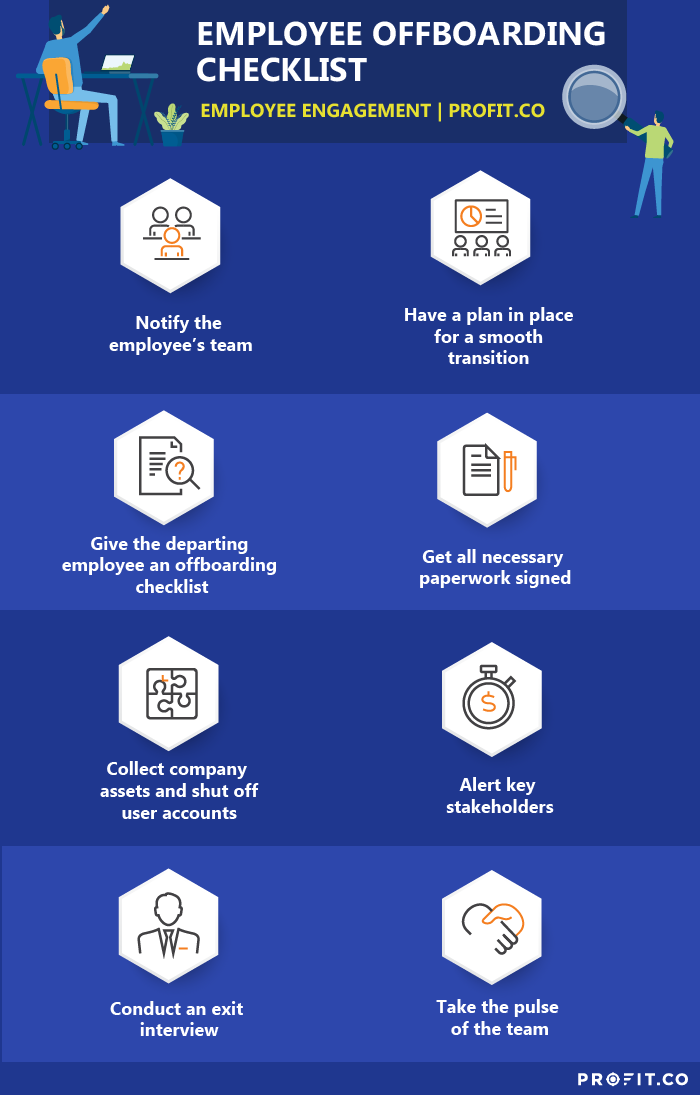What Is Employee Offboarding?
Employee Offboarding is the process that leads to the formal separation between a business and its employee through resignation, termination, or retirement.
Depending on the seniority of the employee, the offboarding process might differ for each employee. This may include:
- Transferring that employee’s job responsibilities and knowledge
- Deactivating access rights and passwords
- Turning in equipment
- Conducting exit interviews to gather feedback
It’s important to understand the employee’s reason for leaving the company, as different types of departures call for different onboarding and timeline action plans.
Train people well enough so they can leave. Treat them well enough so they don’t want to.
However, whatever the reason for the employee’s exit, it’s very important that they are treated with respect, the company knows exactly what needs to be done in their absence and who is going to take over the tasks of the departing employee, and that the business, clients, and employees do not feel any negative repercussions from this change.
What Is the Difference Between Onboarding and Offboarding?
There’s a great deal of forethought that goes into the process of an employee joining an organization and leaving an organization. The onboarding process when an employee joins, and the offboarding process when they leave are two of the most important processes that business leaders must have down to a science.
While many people might highlight onboarding as the more important process of the two, the offboarding process should also be meticulously planned with all the paperwork, expectations, and goals already laid out for HR professionals and managers alike so that the employee-company relationship is not damaged.
Why Is the Offboarding Process Important?
One of the two things can happen when an employee leaves the organization: they might be a promoter for the organization, or be a detractor. Depending on what they are to the organization and how they feel about it, either of those reactions can have a significant impact on the business in the long run. Former employees often review their previous jobs on sites like Glassdoor, which means that their opinion after they leave your organization can either build up or break down your company’s reputation.
The offboarding process is a very powerful tool to turn departing employees into advocates or at the very least, minimize the detractor behavior towards the organization.
When the organization makes an effort to understand the employee’s experience, the employee and organization can part ways without burning any bridges but instead, with opportunities for networking, development, and growth for all parties involved.
Let’s take a look at a step-by-step employee offboarding checklist:
Step-by-Step Employee Offboarding Checklist

Following is a checklist for employee offboarding. Do bear in mind that the reason for the employee’s exit and timeline needs to be kept in mind while following this checklist.
- Notify the employee’s team
- Have a plan in place for a smooth transition
- Give the departing employee an offboarding checklist
- Get all necessary paperwork signed
- Collect company assets and shut off user accounts
- Alert key stakeholders
- Conduct an exit interview
- Take the pulse of the team
1. Notify the employee’s team
Once the employee’s exit has been made official to the HR team, the employee’s team must be informed as well. Make sure that this is done as soon as it’s official to avoid speculation and rumors. Keep the announcement factual with all the details that the team should be aware about: the date the employee is leaving, the transition plans after they leave, and who to contact should there be any questions.
For employees who are leaving on their own accord, be courteous and thank them for their service, while highlighting some key contributions they’ve made to the organization.
2. Have a plan in place for a smooth transition
In order to ensure a smooth transition for voluntary departures, the exiting employee should create detailed documents for their team members to refer to even after they have left the company. Following are some of the details that it must cover:
- Processes explaining how to complete specific tasks
- How to use certain softwares and applications
- Projects the exiting employee is working on currently
- Key contacts– clients, vendors or internal employees they correspond with
- Any login information the team members might need
Make sure there is enough time given to the exiting employee to do a proper and comprehensive handover to the manager and remaining team members.
3. Give the departing employee an offboarding checklist
Once the employee lets the organization know that they are leaving, it might be very clear how they should proceed, and what the next steps are. However, if it’s not clear, the organization runs the risk of stumbling after losing the employee. In order to take the ambiguity out of the equation, companies should provide an offboarding checklist to the exiting employee.
The offboarding checklist should clearly indicate what are the various steps and things that need to be done before they exit the company. This would ensure that everything flows smoothly and the transition would not seem like a rushed one.
4. Get all necessary paperwork signed
Similar to the employee onboarding process, there is necessary paperwork that needs to be signed when the employee leaves to protect the business. This is because a lot of employees who leave take valuable information and ideas with them, or were privy to a lot of sensitive information in their role. Therefore, it’s very important that, when applicable, employees sign thorough non-disclosure agreements to avoid any compliance violations and prevent any private information from leaking to competitors.
5. Collect company assets and shut off user accounts
This step is absolutely crucial in order to keep the business secure. Once the paperwork has been signed, all steps for a smooth transition have been completed, and it’s the employee’s last day at work. Make sure that physical company assets such as company laptop, badge, keys, company credit card etc. have all been collected. Disable all employee accounts from internal databases and their access to information to the company drive on the cloud.
Once the employee is formally out of the company, there is no need for the employee to have any access to company assets.
6. Alert key stakeholders
When the HR team is aware of an employee leaving the organization, they need to notify and work with other departments for a smooth and efficient offboarding process. For example
- Payroll needs to know when the employee’s last day at work is so that they can process their final paycheck and check if the exiting employee owes them any relocation fees or any other fees before they leave.
- IT needs to know when to disable all accounts and their access to company assets on the cloud
- Collect their personal information so that the organization knows when to send them their W-2 Form and other tax documents when it’s available
Ensuring all these departments work together allows for a very organized way of working and avoids last minute scramble.
7. Conduct an exit interview
Never undermine the power of an exit interview. An exit interview is almost like a treasure trove of insights that can help the company perform better and keep employee satisfaction high.
Schedule an exit interview with the employee who’s leaving to have a one-on-one discussion to collect honest feedback about their experience at the organization, the culture, work-life balance and other aspects of their tenure at the organization.
Unlike an employee performance appraisal, this is more about the organization than the individual. Listen to them carefully, and conclude the meeting by thanking them for their contributions to the company.
8. Take the pulse of the team
Once the employee has left the organization, the offboarding process has technically ended. However, never take your eye off the rest of the team. A team member leaving can have a significant impact on the team. And it could also be a sign of more untimely exits.
If a team member leaves and another member does not immediately come on board to take their place, this could mean more responsibilities and work for the rest of your employees.
In order to ensure that your remaining team does not feel overwhelmed or discouraged, issue a pulse survey to gauge employee morale. Take the necessary steps to keep them motivated and engaged.
Are you looking for an employee engagement tool that allows you to communicate, congratulate, and motivate your team virtually? Look no further than Profit.co, a fully integrated software solution that combines OKR, performance, strategy, and task management with employee engagement to help organizations achieve their ambitious goals. You can try Profit.co free for thirty days or book a free demo with our experts to learn more!
In Conclusion
Whatever the reason for the departure of the employee, always remember to send them off with a smile.
If it’s a layoff, remember to be respectful and professional, and thank them for work and contributions. Keep their dignity intact, and don’t make them feel bad about themselves in any way. Let them know that they could use their experience at the organization for reference.
In the case of voluntary exit, celebrate their time at the company. Congratulate them and wish them well for their next endeavor. Do something nice for them and leave the relationship on good terms to reinforce the reputation of the company as a great employer and to give respect and recognition where it is due.

